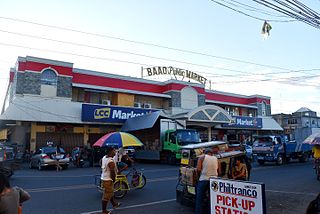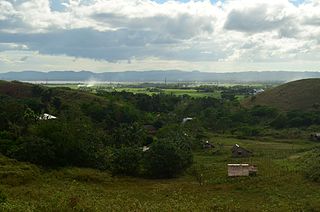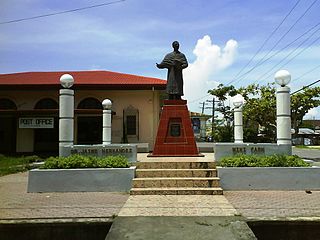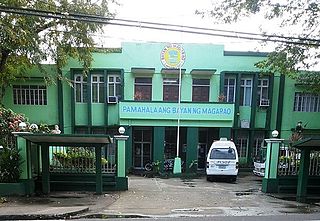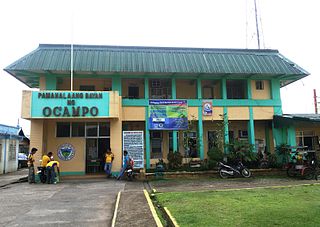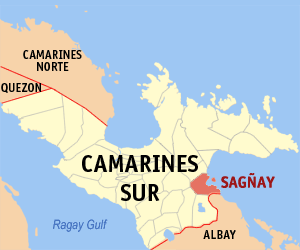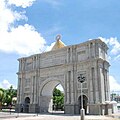Canaman | |
|---|---|
| Municipality of Canaman | |
 | |
| Nicknames: Citadel of Bicol Culture Birthplace of Tancong Vaca Guerilla Unit | |
| Motto(s): "Bangon Canaman!" ("Rise Canaman!") | |
 Map of Camarines Sur with Canaman highlighted | |
Location within the Philippines | |
| Coordinates: 13°39′N123°10′E / 13.65°N 123.17°E Coordinates: 13°39′N123°10′E / 13.65°N 123.17°E | |
| Country | |
| Region | Bicol Region (Region V) |
| Province | Camarines Sur |
| District | 3rd district |
| Founded | 1583 |
| Barangays | 24 (see Barangays) |
| Government | |
| • Type | Sangguniang Bayan |
| • Mayor | Nelson M. Legaspi |
| • Vice Mayor | Venancio B. Regulado |
| • Congressman | Gabriel H. Bordado Jr. |
| • Electorate | 20,446 voters (2019) |
| Area | |
| • Total | 43.27 km2 (16.71 sq mi) |
| Elevation | 5 m (16 ft) |
| Population (2015 census) [3] | |
| • Total | 34,210 |
| • Density | 790/km2 (2,000/sq mi) |
| Time zone | UTC+8 (PST) |
| ZIP code | 4402 |
| PSGC | |
| IDD : area code | +63 (0)54 |
| Climate type | tropical rainforest climate |
| Income class | 4th municipal income class |
| Revenue (₱) | 79.5 million (2016) |
| Poverty incidence | 24.21 (2012) [4] |
| Native languages | Central Bikol Tagalog |
Canaman, officially the Municipality of Canaman, is a 4th class municipality in the province of Camarines Sur, Philippines. According to the 2015 census, it has a population of 34,210 people. [3]

Camarines Sur is a province located in the Bicol Region in Luzon of the Philippines. Its capital is Pili and the province borders Camarines Norte and Quezon to the northwest, and Albay to the south. To the east lies the island province of Catanduanes across the Maqueda Channel.

The Philippines, officially the Republic of the Philippines, is an archipelagic country in Southeast Asia. Situated in the western Pacific Ocean, it consists of about 7,641 islands that are categorized broadly under three main geographical divisions from north to south: Luzon, Visayas and Mindanao. The capital city of the Philippines is Manila and the most populous city is Quezon City, both part of Metro Manila. Bounded by the South China Sea on the west, the Philippine Sea on the east and the Celebes Sea on the southwest, the Philippines shares maritime borders with Taiwan to the north, Japan to the northeast, Vietnam to the west, Palau to the east, and Malaysia and Indonesia to the south.
Contents
- Etymology
- History
- Philippine-American War
- World War II
- Climate
- Barangays
- Demographics
- Economy
- Culture
- Transportation
- References
- External links
A landlocked municipality centrally located in the province of Camarines Sur, it is bounded on the north by Magarao, on the south by Gainza and Camaligan, on the east by Naga City, and on the south-west by the broad Bicol River. From north to south it is 6 kilometres (3.7 mi) long, and 14 kilometres (8.7 mi) wide from east to west.

Naga, officially the City of Naga, or simply Naga City, is a 2nd class independent component city in the Bicol Region, Philippines. According to the 2015 census, it has a population of 196,003 people.

The Bicol River is the eighth largest river in the Philippines in terms of drainage basin size with an estimated catchment area of 3,770 square kilometres (1,460 sq mi). The river drains the southwestern part of the island of Luzon and passes through Camarines Sur province in the Bicol Region.




